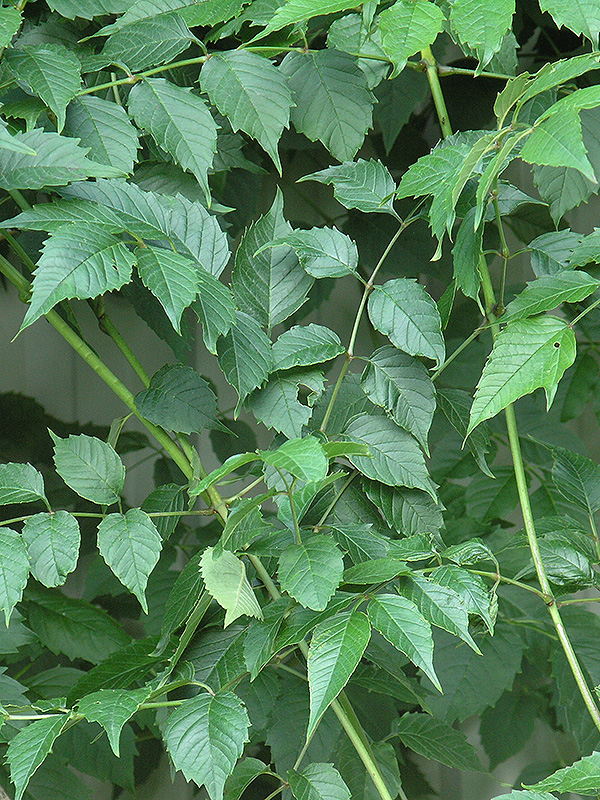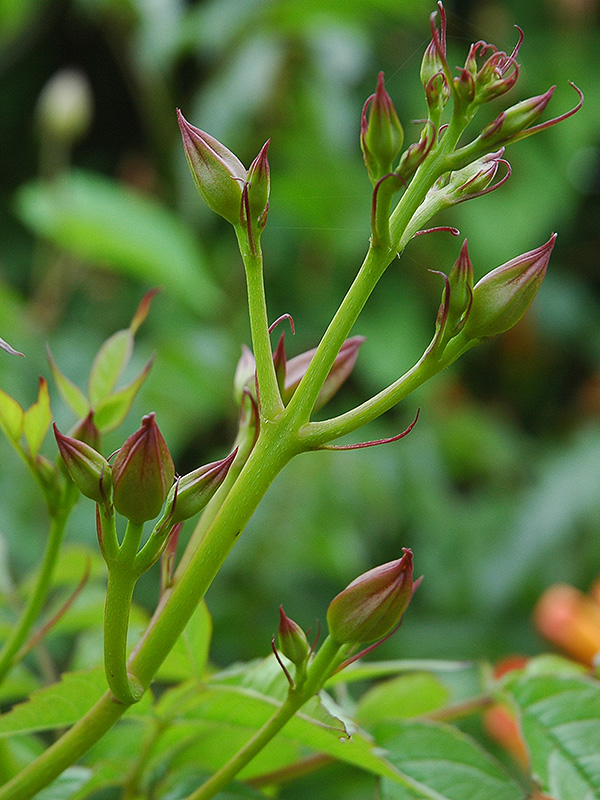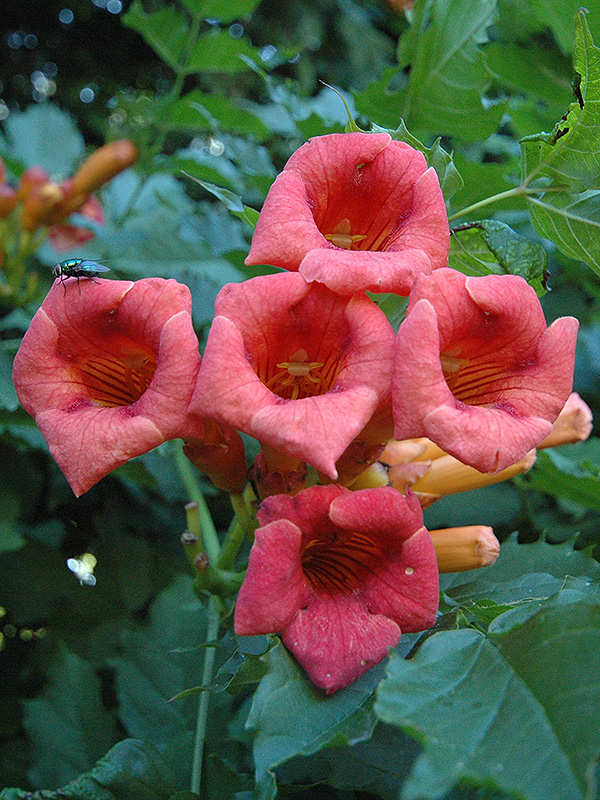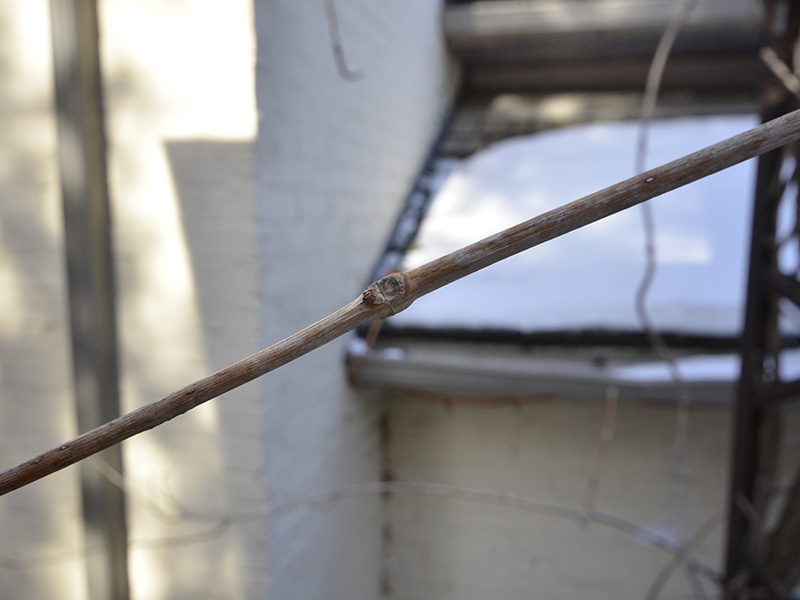
Woody > Campsis > Campsis radicans > Campsis radicans
Campsis radicans
Common Trumpetcreeper, Trumpet Vine, Cow Itch Vine
Origin: Missouri, United States of America.
Mike's
Opinion


"
A very vigorous vine that is grown for its large, tubular, orange blooms that are held in umbels, where each individual bloom can be up to 10 cm in length. Easily grown in full sun to partial shade, it is often seen enveloping old buildings where the vigorous pruning hand of the gardener has not been for several years. It can become very invasive due to its ability to produce new shoots from the roots.
Michael Pascoe, NDP., ODH., CLT., MSc. (Plant Conservation)
"
| Family |
| Bignoniaceae |
| Genus |
| Campsis |
| Species |
| radicans |
| Category |
| Woody |
| Type |
| Vine |
| Pronunciation |
| USDA Hardiness Zone |
| 4 - 9 |
| Canadian Hardiness Zone |
| 5 |
| RHS Hardiness Zone |
| H7 - H3 |
| Temperature (°C) |
| (-32) - (-1) |
| Temperature (°F) |
| (-25) - 30 |
| Height |
| 10 m (vine) |
| Spread |
| 5 m (vine) |
Photographs
Description and Growing Information
Flowering Period
| General Description |
| A very aggressive deciduous woody vine that is most commonly planted for its trumpet shaped flowers, hence its common name. It is very drought tolerant, fast growing, and easy to propagate, making it a popular grow in residential communities. The flowers attract hummingbirds, so it is often planted to attract these interesting pollinators. |
| Landscape |
| These plants tend to be planted along a fence, wall, arbour, pole, or large trellises to spice things up or act as a divider. Can also be used to cover up sore sights such as rock piles or mounds of dirt. The plant attracts hummingbirds so it is often used in woodland gardens, naturalized areas, or residential gardens of those who enjoy bird watching. |
| Cultivation |
| Campsis radicans enjoys moist but never soggy soil with a pH minimum of 4.9 and a maximum of 6.8. It can tolerate various soil compositions, but prefers a rich soil to help with its fast growth. The vine prefers a sunny position but is very drought tolerant. It prefers full sun but will tolerate partial shade. It requires support to climb up so be sure to plant near a fence or other support object. Lastly, the plant will require pruning to keep it from overtaking its surroundings. |
| Shape |
| A single crowned vine. |
| Growth |
| Fast |
| ID Characteristic |
| Most easily identified by its long tubular trumpet shaped flowers, that are brightly coloured red, yellow, or orange. It's woody stems and shiny, coarsely toothed and deep green opposite pinnate leaf shape are also a good indicator of the plants identification. |
| Pests |
| In rare cases could be susceptible to spider mites, scale insects, whiteflies, and mealybugs due to its honeydew. The most common diseases are powdery mildew and leaf spot. Mildew is much more common however. To prevent these diseases ensure good circulation and destroy early signs of infection. |
| Habitat |
| The Trumpet Vine is found in moist, old forests, against trees or along old fences in fields. Also in thickets, waste grounds, railroads, or other areas that tend to be left unattended for long periods of time. |
| Bark/Stem Description |
| Young stems are pale green that turn tan as they age, and are covered in aerial roots. Older stems exhibit secondary growth and become pale brown, woody, peel-able, scaled bark. They can grow several centimetres in diameter if left unpruned. |
| Flower/Leaf Bud Description |
| Buds resemble small upside down triangles. They grow individually as opposed to clusters and are sessile or with tiny petioles. |
| Leaf Description |
| Deciduous, to 40 cm long, pinnate, opposite leaf arrangement, obovate or elliptic in shape. Pinnate venation with a dentate leaf margin. Leaves are very shiny and have a smooth texture. |
| Flower Description |
| A trumpet shaped flower 7-10 cm in length that blooms bright orange, red or yellow for a good portion of the summer. |
| Fruit Description |
| An elongated, green, slender capsule that resembles a bean, 7.5-12 cm long, 2 cm wide filled with numerous flat seeds. |
| Colour Description |
| The bright shiny green leaves of summer turn a pale uninteresting yellow in autumn. The Flowers that bloom in June are a glorious red, orange, or yellow. The bark is pale brown in old growth and a light green to tan on new growth. |
| Texture Description |
| Plant is medium in texture during spring, summer and early autumn but fairly coarse in late autumn and winter. |
| Notable Specimens |
| Weldon Library, University of Western Ontario, London, Ontario, Canada. |
| Propagation |
| Propagation is very easy with this aggressive vine. By seed, 2 months at 5°C. Softwood cuttings and root cuttings also work very well. |





